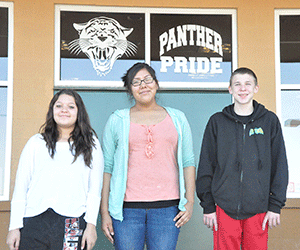
Joseph Rice, Emily Cordero and Elise Brown Thunder have very different personalities, but they have a lot in common.
Smarts, for one. The eighth graders gravitated to Maricopa Unified School District’s 20+1 program that caters to gifted students. They also attend Maricopa Wells Middle School and have curious minds.
Elise and Emily have known each other since fourth grade. Emily and Joseph worked together on a project last year. As the competition known as Future Cities approached, Emily thought Elise was just the addition the duo needed to make something special.
It was so special, in fact, the teamwork took them all the way to Washington, D.C. There they had as much fun playing in the snow and networking with other teams as they did presenting their project.
“We’re very proud of it,” Elise said of their Future City, called Diamont de L’Arizona.
They wanted to keep it real when creating a new world and not get whimsical and impractical. This year’s theme was urban agriculture. Their city had to have access to a protein, a vegetable and water. The trio also wanted their project to reflect their home.
“We knew Arizona had agricultural issues because of water,” Elise said. “So we selected the prickly pear and bee pollen.”
“We knew they went together and they were natural to our environment,” Emily said. “The point of Future Cities is to think of actual solutions.”
“We were working on it from the first day of school,” Joseph said. “We started about two months before competition as far as research.”
They reached nationals by winner the Arizona Regional, but they found a different kind of atmosphere in Washington, D.C. In Phoenix, the judges had looked over the projects and decided which ones they wanted to hear from. At nationals, Elise compared the judging to speed-dating.
They were given 10 minutes to make their presentation, and judges would cut them off and force them back on track if they rambled.
They also did not get to see the teams that competed before them. They only heard that the first team went out and threw down the gauntlet.
“Then they said we set it aside and surpassed it,” said Joseph, whose competitive nature has him replaying every competitor’s ideas, any perceived slights and judging anomalies.
Looking around, Emily said she felt confident they would be top five. There were a variety of awards to be gained even when they did not land first, and Joseph said they were aiming for the “society awards.” Diamont won the awards for Best Residential Zone and Most Sustainable Food Production System.
“We didn’t know there was an award for that per se, so we were like, ‘What?’” said Joseph.
Joseph, whose mother Robyn is a 20+1 teacher, has been involved in Future Cities for three years. This was Elise’s second year and Emily’s first. It was the first time in Washington for all of them. It was also Emily’s first experience flying and her first time in the snow.
They quickly made friends among their competitors, especially the winning Michigan team. Elise said everyone had very good models, and her favorite idea was a flying boat.
The Arizona Regional is one of the most heavily contested in the country. Many states have comparatively few teams competing, and familiar faces often show up at the national contest. Arizona, on the other hand, is known for having new champions every year.
That made winning the region, which Diamont de L’Arizona did, all the more prestigious for the three, who had Sarah Skrnich as project manager. Guidance from strong teachers and help from assigned engineers put them over the top.
Finally back from the nation’s capital, they were honored by the MUSD School Board Wednesday. Now they get to present their winning city model at the Arizona Science Center on Saturday.
And they are not quite done with Future Cities, either. All three expect to return as high schoolers next year to help MWMS students with their projects. The school had eight Future Cities teams this year.
***ADVERTISEMENT***Joe Szoltysik, one of the district’s blended-learning teachers, pointed out Future Cities was just one of the many challenges in the 20+1 program, which is project based learning.
Earlier this school year, students at MWMS and Desert Wind Middle School solved crimes. Later they will be building rockets with General Dynamics. And in a change of pace, they will present Historical Performance Art pieces and designing video games.
“And this is all happening while we do our normal curriculum on a daily basis,” Szoltysik said.

![Who’s the Best Mom InMaricopa? Nominate now! Marlene Marshall, Christina Olivares, and Meghan Bremer. [Bryan Mordt]](https://www.inmaricopa.com/wp-content/uploads/2023/05/BCM_8465-218x150.jpg)



![Maricopa sheds tears amid Maui wildfires that killed dozens For Maricopa resident Janelle Gomez, the sorrow mirrors the loss of a family member. [Brian Petersheim]](https://www.inmaricopa.com/wp-content/uploads/2023/08/Gomez-218x150.jpg)
![Embracing Freedom: Celebrating the Fourth of July Councilmember Vincent Manfredi at Great American 4th 2021 [Victor Moreno]](https://www.inmaricopa.com/wp-content/uploads/2023/07/2021-Great-American-4th-e1688414543522-218x150.jpg)





![Alleged car thief released without charges Phoenix police stop a stolen vehicle on April 20, 2024. [Facebook]](https://www.inmaricopa.com/wp-content/uploads/2024/04/IMG_5040-218x150.jpg)

![MHS G.O.A.T. a ‘rookie sleeper’ in NFL draft Arizona Wildcats wide receiver Jacob Cowing speaks to the press after a practice Aug. 11, 2023. [Bryan Mordt]](https://www.inmaricopa.com/wp-content/uploads/2024/04/cowing-overlay-3-100x70.png)


